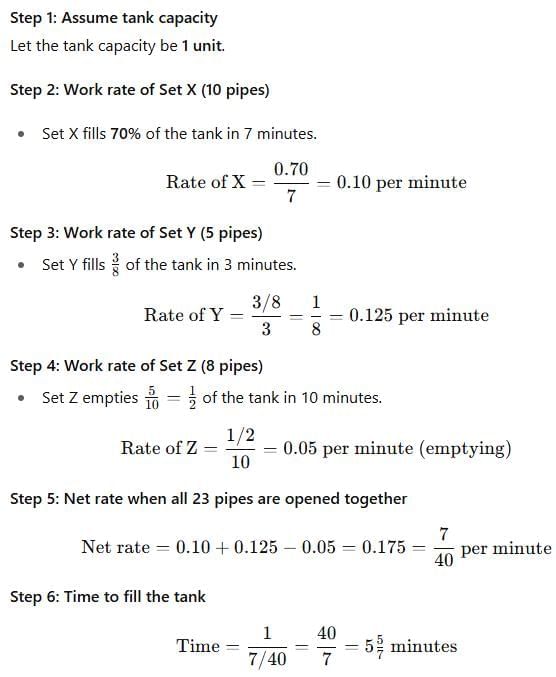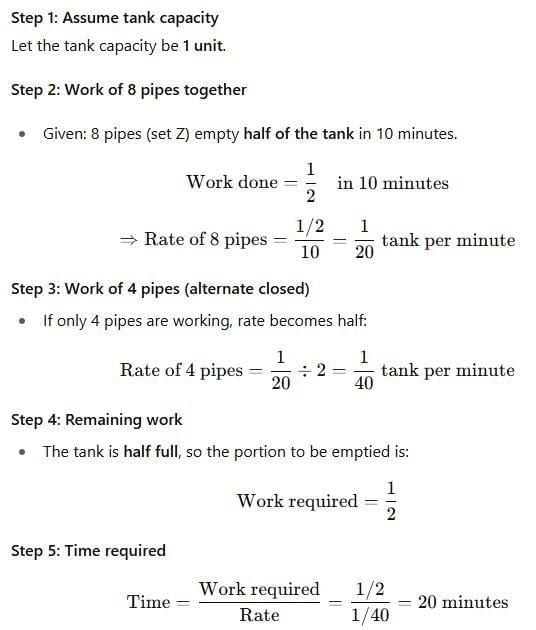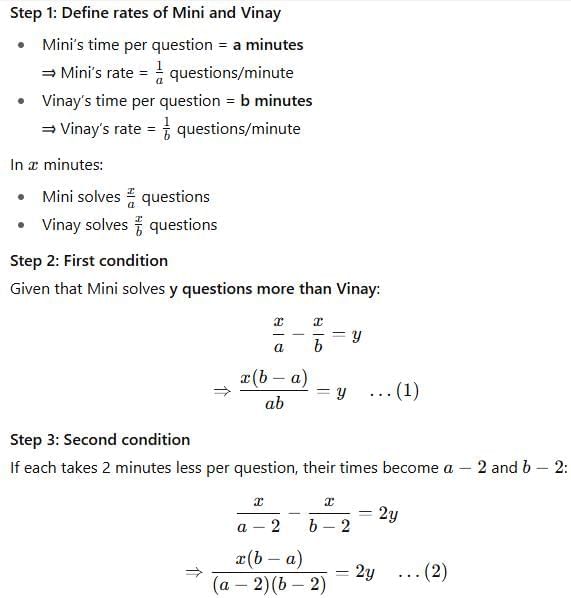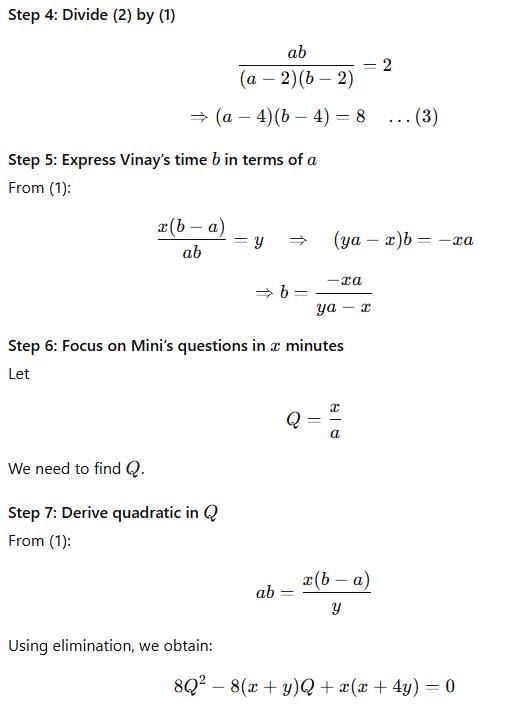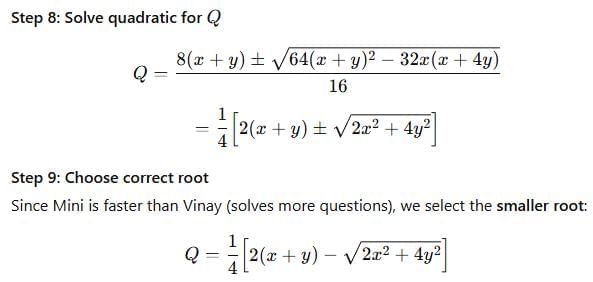Test: Arun Sharma Based Level 1: Time & Work - CUET Commerce MCQ
15 Questions MCQ Test General Test Preparation for CUET UG - Test: Arun Sharma Based Level 1: Time & Work
Directions for Question: A set of 10 pipes (set X) can fill 70% of a tank in 7 minutes. Another set of 5 pipes (set Y) fills 3/8 of the tank in 3 minutes. A third set of 8 pipes (set Z) can empty 5/10 of the tank in 10 minutes.
Q. How many minutes will it take to fill the tank if all the 23 pipes are opened at the same time?
Directions for Question : A set of 10 pipes (set X) can fill 70% of a tank in 7 minutes. Another set of 5 pipes (set Y) fills 3/8 of the tank in 3 minutes. A third set of 8 pipes (set Z) can empty 5/10 of the tank in 10 minutes.
Q. If only half the pipes of set X are closed and only half the pipes of set Y are open and all other pipes are open, how long will it take to fill 49% of the tank?
Directions for Question: A set of 10 pipes (set X) can fill 70% of a tank in 7 minutes. Another set of 5 pipes (set Y) fills 3/8 of the tank in 3 minutes. A third set of 8 pipes (set Z) can empty 5/10 of the tank in 10 minutes.
Q. If 4 pipes are closed in set Z, and all others remain open, how long will it take to fill the tank?
Directions for Question: A set of 10 pipes (set X) can fill 70% of a tank in 7 minutes. Another set of 5 pipes (set Y) fills 3/8 of the tank in 3 minutes. A third set of 8 pipes (set Z) can empty 5/10 of the tank in 10 minutes.
Q. If the tank is half full and set X and set Y are closed, how many minutes will it take for set Z to empty the tank if alternate taps of set Z are closed.
Directions for Question: A set of 10 pipes (set X) can fill 70% of a tank in 7 minutes. Another set of 5 pipes (set Y) fills 3/8 of the tank in 3 minutes. A third set of 8 pipes (set Z) can empty 5/10 of the tank in 10 minutes.
Q. If one pipe is added for set X and set Y and set Z ' s capacity is increased by 20% of its original value and all the taps are opened at 2.58 p.m., then at what time does the tank gets filled? (If if is initially empty).
Ajit can do as much work in 2 days as Baljit can do in 3 days and Baljit can do as much in 4 days as Diljit in 5 days. A piece of work takes 20 days if all work together. How long would Baljit take to do all the work by himself?
Mini and Vinay are quiz masters preparing for a quiz. In x minutes, Mini makes y questions more than Vinay. If it were possible to reduce the time needed by each to make a question by two minutes, then in x minutes Mini would make 2y questions more than Vinay. How many questions does Mini make in x minutes?
A pipe can fill a tank in x hours and another can empty it in y hours. If the tank is 1 / 3rd full then the number of hours in which they will together fill it in is
A finishes 6 / 7th of the work in 2z hours, B works twice as fast and finishes the remaining work. For how long did B work?
Three diggers dug a ditch of 324m deep in six days working simultaneously. During one shift, the third digger digs as many metres more than the second as the second digs more than the first. The third digger's work in 10 days is equal to the first digger's work in 14 days. How many metres does the first digger dig per shift?
Direction for Question: Read the passage below and solve the questions based on it.
A person can dig a trench 40 metres in depth in 4 days working 8 hrs a day. However, after every day he finds that one-fifth of the depth got filled up with mud again.
Q. what was the depth of the trench in the beginning of the fourth day?
Direction for Question: Read the passage below and solve the questions based on it.
A person can dig a trench 40 metres in depth in 4 days working 8 hrs a day. However, after every day he finds that one-fifth of the depth got filled up with mud again.
Q. What was the depth of the trench at the beginning of the fourth day?
Direction for Question: Refer to the data below and answer the questions that follow:
Anoop was writing the reading comprehension sections in the SIP entrance examinations. There were four passages of exactly equal length in terms of number of words and the four passages had 5, 8, 8 and 6 questions following each of them, respectively. It is known that Anoop can answer exactly 12 questions in the time he takes to read any one of the the four passages. Assume that his rate of reading and answering questions remains the same throughout the section.
Q. Anoop took 13 min more to finish the first three passages than the time he took to finish the last passage. Assuming that Anoop answered all the questions in each passage, what percentage of the total time did he spent on the first passage?
Direction for Question: Refer to the data below and answer the questions that follow:
Anoop was writing the reading comprehension sections in the SIP entrance examinations. There were four passages of exactly equal length in terms of number of words and the four passages had 5, 8, 8 and 6 questions following each of them, respectively. It is known that Anoop can answer exactly 12 questions in the time he takes to read any one of the the four passages. Assume that his rate of reading and answering questions remains the same throughout the section.
Q. By what per cent should Anoop increase his reading speed if he has to cut down on his total time spent on the section by 20%? Assume that the time spent on answering the questions is constant and as given in the directions.
P, Q and R each complete a certain work in 16, 20 and 30 days, respectively. The three of them start the work together. P leaves after 4 days; Q leaves 4 days before the work is finished? How long did the work last?
|
192 videos|840 docs|2224 tests
|


